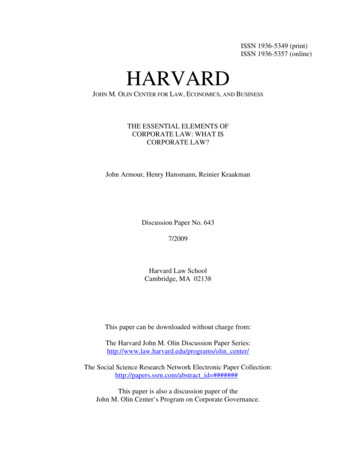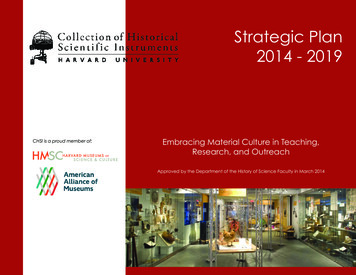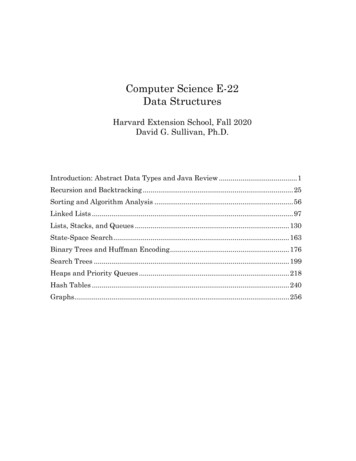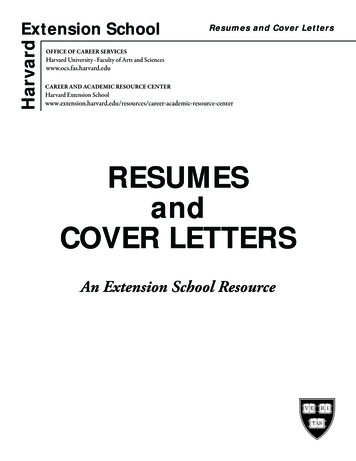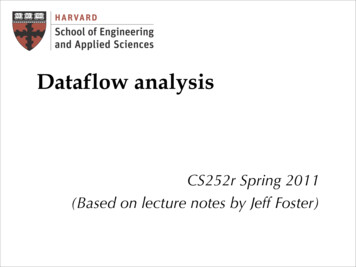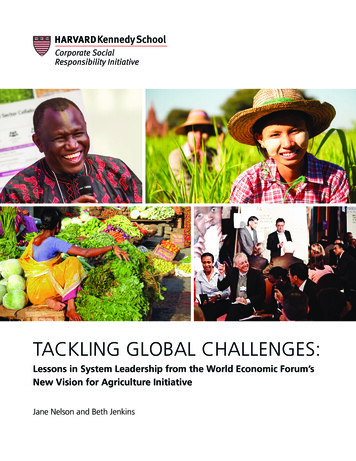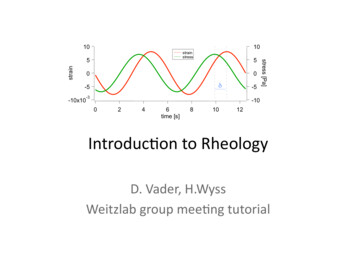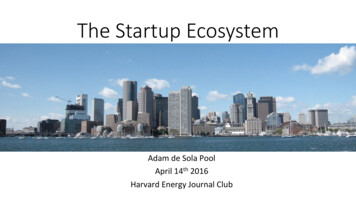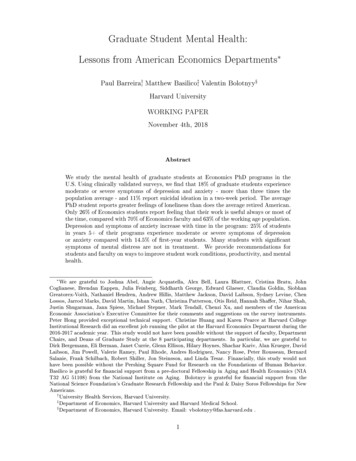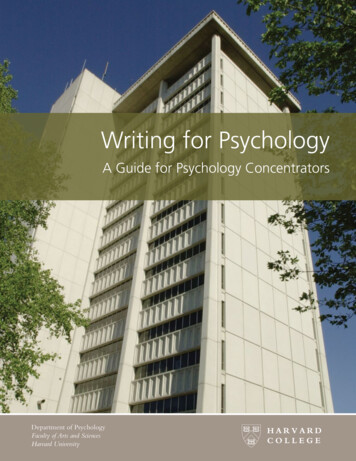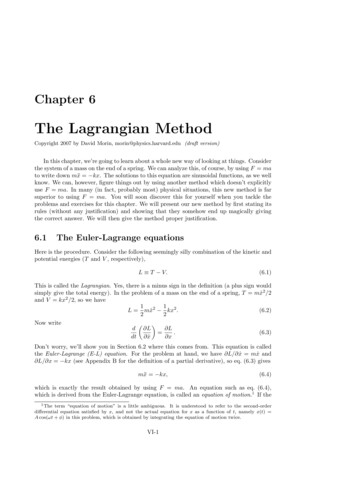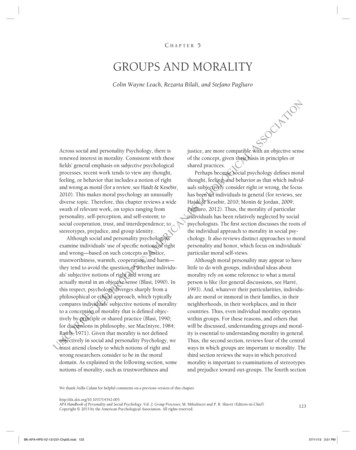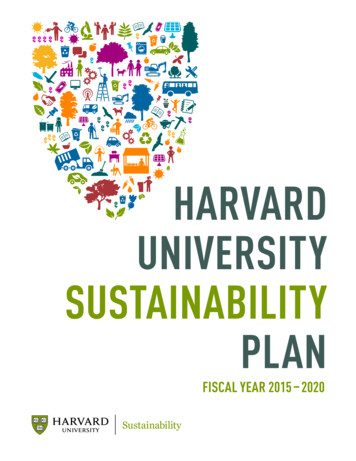
Transcription
HARVARDUNIVERSITYSUSTAINABILITYPLANFISCAL YEAR 2015 – 2020
The Harvard Sustainability Plan is theUniversity’s roadmap for building andoperating a healthier, more sustainablecampus community. The Plan alignsHarvard’s decentralized campus around aholistic vision and sets clear University-widegoals and priorities based on the innovationsand solutions that have been developed atour individual Schools and departments.EARLY YEARSOne of the first formal campussustainability initiatives launched,Sustainability Principles defined(2001-2004)BEGINNINGPrograms initiated to spur change:Green Revolving Fund, CommuterChoice,Harvard Recycling 92000200120022003
CONTENTS2Foreword5Introduction7Roadmap to a Sustainable CommunityEMISSIONS ANDCAMPUSNATURE ANDHEALTH ANDCULTURE 418202228Stakeholder Engagement31Implementation and Reporting32AppendicesONWARDBuild on progress with aholistic vision for a moresustainable campus byfostering interdisciplinaryconnections to driveinnovation, student/facultyconnection with on-campuschallenges, and partnershipswith external institutions(2015 and forward)UNIVERSITY-WIDE PRIORITYAmbitious Greenhouse Gas Reduction Goaland Green Building Standards set. Communitymobilized to institutionalize sustainability andSustainability Plan launched 320142015HARVARD UNIVERSITY SUSTAINABILITY PLAN 1
FOREWORDPresident DREW GILPIN FAUSTWorldwide scientific consensus has clearlyestablished that climate change and thechallenges of environmental sustainability posea serious threat to our future—and, increasingly,to our present. Harvard has long recognized itsresponsibility to confront these challenges as partof its special accountability to the future. Fulfillingthese obligations must be our common purposeand our shared commitment.Each member of our community hasHarvard must also be committed toThe Harvard Sustainability Plan, devel-a role to play in this effort.modeling an institutional pathway to aoped in consultation with a wide rangemore sustainable campus. Our goal toof University stakeholders, seeks toreduce greenhouse gas emissions isbuild on our progress. It considersthe University’s most ambitious effortthe University’s role in the world andto date, but our students, faculty,recognizes our shared responsibilityand staff have also harnessed theirto build and operate a campus thatcreativity to build a healthier campuscontributes to the well-being of everyin which to learn, work, and live.member of our community—andHarvard’s commitment to sustain-ultimately to the health of the planet.ability has united individuals acrossIt recognizes that creating a sustain-our Schools around common goalsable campus strengthens our coreand a strong vision for a more vibrantresearch and teaching mission, andcommunity.it acknowledges that the challengesWe must continue to generate newideas and spur exciting innovationsby collaborating across disciplinesas we develop solutions to pressingglobal challenges. From creating newmaterials that revolutionize solarenergy production, to probing thehuman influences on climate change,to providing analysis to policy-makers,faculty and students are makingimportant contributions and helpingto ensure a more sustainablefuture. Our teaching and researchacross Harvard—in climate science,engineering, law, public health,policy, design, and business—has anunparalleled capacity to acceleratethe progression from nonrenewable torenewable sources of energy.2 HARVARD UNIVERSITY SUSTAINABILITY PLANThe Harvard Sustainability Plan recognizes that creatinga sustainable campus strengthens our core research andteaching mission, and it acknowledges that the challengesbefore us are complex and interconnected, demanding anever-developing approach to sustainability.”
In October 2008, President Faust hosted a Sustainability Celebration to rally the communityaround Harvard’s greenhouse gas reduction goal—15,000 people attended, and Vice Presidentand Nobel Laureate Al Gore delivered the keynote address. One bag of trash was created.before us are complex and intercon-Together, we must create that future. Inected, demanding an ever-devel-want to extend my deep appreciationoping approach to sustainability.to Executive Vice President Katie LappThe Harvard Sustainability Plan is acritical and necessary step forwardin building a more sustainable future,a future in which our research andteaching inform solutions to problemson our campus and far beyondit; in which ideas, innovation, anddiscovery are considered indispensable elements in combating globalchallenges; and in which actionsrelated to energy and the environmentare complemented by efforts toimprove human health and well-being.and the Office for Sustainability forleading the development of this Plan.I also want to thank the hundreds offaculty, students, and staff in facilities,Campus Services, and elsewhere whocontributed to the creation of thePlan. Their work across disciplinesand Schools speaks to the power ofcollaboration and teamwork, and itembodies the perennial goal of usingthe great talent that exists throughoutthe University to achieve somethingeven greater together.Students arriving today ought to leaveHarvard with a deeper understandingof the complexity of sustainabilitychallenges and be ready to addressPresident Drew Gilpin Faustthem no matter where their lives maylead.HARVARD UNIVERSITY SUSTAINABILITY PLAN 3
INTRODUCTIONWILLIAM CLARK, Harvey Brooks Professor ofInternational Science, Public Policy and HumanDevelopment, Harvard Kennedy School, andJACK SPENGLER, Akira Yamaguchi Professor ofEnvironmental Health and Human Habitation,Harvard T.H. Chan School of Public Health.What does sustainabledevelopment mean for aninstitution like Harvard University?The United Nation’s Brundtland Commission Report of 1987concluded that humanity has the ability to make development sustainable if it meets “the needs of the presentwithout compromising the ability of future generations tomeet their own needs.”The Brundtland Report was the catalyst that helped focushumanity on our obligations to future generations as well asto the importance of developing people, not just protectingthe environment. However, there is a growing consensusamong scholars and leaders around the world that we mustnow build on the Brundtland Report by incorporating adeeper consideration of human well-being into the evolvingapproach to sustainable development on local, regional, andglobal levels.That consensus argues that when governments, firms, andother organizations consider their possible paths towardsustainable development, they should focus on implicationsfor the well-being of individual people aggregated within andacross generations.Well-being depends, of course, on conservation of naturalresources and the environment. But there are also otherassets from which a society can draw to shape its own wellbeing to pass on to successive generations. A systematicHarvard has more LEED certified building projects thanany higher education institution in the world (U.S. GreenBuilding Council). These living, green walls were partof the LEED Platinum renovation of Harvard GraduateSchool of Education’s Gutman Library.4 HARVARD UNIVERSITY SUSTAINABILITY PLANapproach to the challenges of sustainable developmentmust appreciate the contributions to our intergenerational
well-being of each of these assets,well-being be explicitly considered inteaching, but also through itsplus the trade-offs and interactionsour sustainable development plans?”operations. Sustainable developmentamong them:and “What steps will we take on ourat Harvard involves more thancampus to manage this full rangesimply reducing our campus’ impactof assets so as to benefit humanon the surrounding environment.well-being over the long term?” InRather, we must strive to cultivate aHarvard’s case, grappling with theserobust community that supports theManufactured capital (e.g. housing,questions becomes a device forwell-being of everyone who passeselectrical generating capacity, andasking what we want to promote inthrough our gates, even as we pursuetransportation)order to help make our campus, andour broader missions of research andthe communities of which we areteaching.Natural capital (e.g. biodiversity andcapacity to fix energy from the sun)Human capital (e.g. population sizeand distribution, personal health,and education)part, more sustainable. What are thespecific constituents of well-beingthat most concern us? How are wethinking about them in terms ofconsequences, not just for us, butSocial capital (e.g. norms, values,also taking into account positive orlaws, institutions, and trust in them)negative impacts we have on otherstoday and in the future?Knowledge capital (e.g. publicHarvard is a thriving academicknowledge created through experi-community that is uniquely positionedence, invention, and research).to engage in a robust dialogue aroundThe creation of Harvard’s firstUniversity-wide Sustainability Planis much more than an exercise instrategic planning. It is an opportunityfor every member of our communityto reflect on what role they can play inenhancing our collective well-being fora more sustainable future.these questions and what it trulyOrganizations, including HarvardUniversity, must ask themselves: “Howwill these important determinants ofmeans to be an organization thatsupports sustainable developmentnot only through its research andThe creation of Harvard’s first University-wide Sustainability Plan is much more thanan exercise in strategic planning. It is an opportunity for every member of our communityto reflect on what role they can play in enhancing our collective well-being for a moresustainable future.”HARVARD UNIVERSITY SUSTAINABILITY PLAN 5
Harvard College’s House renewal initiative seeks to reinvigorate the historic undergraduateHouse system, enhancing the student experience for generations to come. In addition tocreating program and healthy living spaces to meet the changing needs of learning in the 21stcentury, sustainability is another goal that is helping guide all renewal projects.6 HARVARD UNIVERSITY SUSTAINABILITY PLAN
ROADMAP TO ASUSTAINABLE COMMUNITYClimate change and environmental degradation are global problems that requirea bold, clear response from organizations, governments, and businesses. HarvardHarvard must modelan institutionalpathway toward amore sustainablefuture.”University is confronting these challenges through research and teaching, and byturning research into action in order to model an institutional pathway to a moresustainable future.The University’s network of campuses is a living, breathing ecosystem set withinan urban environment that includes 12 Schools, dozens of administrative andPRESIDENTDREW GILPIN FAUSToperational groups, a broad range of building types and land uses, and a diversegroup of tens of thousands of faculty, students, and staff. From an institutionalstandpoint, we aim to transform the University into a sustainable community thatcontributes positive social, economic, and environmental benefits. We are dedicated to institutionalizing best practices in sustainable operations and translatingresearch and teaching into practice by using our campus to pilot innovativesolutions that can be widely replicated. We also have a deepermandate that goes to the heart of Harvard’s research andteaching mission: to educate and empower our studentswhile on campus to become leaders who will use theirknowledge to create sustainable impact in serviceto the world.EDUCATE &EMPOWERour students while oncampus to become leaderswho will use their knowledgeto create sustainable impactin service to the world.Harvard’s commitment is driven bySustainability Principles, adoptedin 2004, which provide a broadvision to guide University-wideTRANSLATEsustainability initiatives. In2008, President Faust and theDeans approved Harvard’smost ambitious sustainabilitycommitment to date: a long-research and teachinginto practice, and useour campus to pilotinnovative solutions toreal-world challenges.LEARN IT.LIVE IT.INSTITUTIONALIZEbest practices insustainable operations.term commitment to reducethe University’s greenhousegas emissions by the maximumpracticable rate aligned with the bestavailable science, and a short-term goal toreduce greenhouse gas emissions 30% by 2016,AMPLIFYimpact by sharing replicablemodels that can be implementedinside and outside Harvard.including growth, from a 2006 baseline. This goalmobilized the University community and allowed theOffice for Sustainability to establish a framework forHARVARD UNIVERSITY SUSTAINABILITY PLAN 7
creating, scaling, and achieving University-wide goals by facilitating teamworkacross disciplines and sectors. In addition, the University has achieved significantprogress in areas beyond energy and emissions including sustainable transportation, healthy operations and maintenance, employee engagement, and studentgreen living.The centerpiece of Harvard’s strategy is scaling sustainable change formaximum impact. We empower our community to innovate on the local leveland then identify those solutions that can be replicated and scaled up across theUniversity. These replicable models are also shared with our peers in the business,government, and higher education sectors to scale change beyond the boundariesof our campus.The Harvard Sustainability Plan builds off of this framework and is the next stepin the University’s evolving commitment to sustainability. It is our roadmap forbuilding and operating a healthier, more sustainable campus community. TheHarvard Office for Sustainability led the development of the Plan with extensivefeedback from hundreds of faculty, students, and facilities and operational expertsacross the University.The Plan aligns our decentralized campus around a holistic vision and sets clearUniversity-wide goals and priorities based on the innovations and solutions thathave been developed at our individual Schools and departments. It is intended tobe practical and operational from Fiscal Year 2015 through Fiscal Year 2020 andcovers the entirety of Harvard’s campus in North America, spanning all Schools,administrative departments, and properties.The existing short-term goal to reduce greenhouse gas emissions is integratedinto this Plan and will be revisited in 2016 when a Task Force is scheduled to recommend new greenhouse gas and energy reduction goals as part of a quadrennialreview process. We fully expect that, in many cases, Harvard’s Schools and departments will exceed these goals and continue to innovate and push for the nextgeneration of sustainability solutions.We tap into the creative ideas that our students, faculty, andstaff are generating and then work to replicate them Universitywide for greater impact.”HEATHER HENRIKSEN, DIRECTOR, HARVARD OFFICE FOR SUSTAINABILITY8 HARVARD UNIVERSITY SUSTAINABILITY PLAN
The Harvard Sustainability Plan is organized around the five core topics ofEmissions and Energy, Campus Operations, Nature and Ecosystems, Healthand Well-Being, and Culture and Learning. Each topic includes areas of focuswith specific actions that are organized within three categories:1. GOAL University-wide resource reduction goals with a specific target withina set timeframe.2. STANDARD Operational standards to facilitate alignment across theUniversity, ensuring that a consistent approach is being implemented.Standards are designed to allow flexibility for how they are implementedby individual Schools and administrative departments.3. COMMITMENT A statement of commitment or recommendation for futureresearch in areas where there was not enough information to set a specificnumeric goal or standard.This Plan should be seen as a living document. It sets a University-wide baselinefrom which we can continue to innovate and explore new ideas for the greaterHelping studentsaccess the tools to livemore sustainably atHarvard is one of ourcore priorities and wehope they’ll take thosetools with them in theclassroom to explorethe next generation ofsolutions that will leadto a healthier planet.”JASMINE WADDELL,RESIDENT DEAN OFFRESHMEN, ELM YARDgood. By providing a foundation for improved reporting and accountability, it alsohelps us create a stronger platform for better assessing our true University-wideimpacts and results. We expect it to evolve and change over time, with a formalprocess to review and set new goals every five years.HARVARD UNIVERSITY SUSTAINABILITY PLAN 9
The Common Spaces Program is exploring how the physical environment canenhance and sustain the vitality of the University community. The initiative hassponsored a wide variety of programs and events, including colorful chairs inHarvard Yard, Wellness Wednesdays, and pop-up creative art performances.10 HARVARD UNIVERSITY SUSTAINABILITY PLAN
OUR ROADMAPEMISSIONS AND ENERGYCAMPUS OPERATIONSGREENHOUSE GAS EMISSIONSNEW CONSTRUCTIONENERGY REDUCTIONBUILDING OPERATIONSRENEWABLE ENERGYTRANSPORTATIONNATURE AND ECOSYSTEMSCLIMATE PREPAREDNESSAND CAMPUS RESILIENCEPROCUREMENTLANDSCAPE OPERATIONSCAMPUS DESIGNCONSERVATION AND EDUCATIONCULTURE AND LEARNINGRESEARCH AND TEACHINGGOVERNANCEHEALTH AND WELL-BEINGEXTERNAL PARTNERSHIPSPERSONAL WELL-BEINGCOMMUNICATIONSFOODCOMMUNITY ACTIONHARVARD UNIVERSITY SUSTAINABILITY PLAN 11
EMISSIONS AND ENERGYWe have a special role and a special responsibility to confront thechallenge of climate change by reducing campus greenhouse gasemissions by the maximum practicable rate. Reducing energy andemissions remains one of the University’s top priorities, and we willcontinue to meet this challenge through best-in-class innovations inenergy efficiency, energy management, and renewable energy.In 2008, Harvard established a long-term commitment to reduce greenhouse gas emissions based on the best available scienceand set a short-term goal to reduce University-wide emissions 30% by 2016. In 2016, the University will develop new greenhousegas emissions and energy reduction goals based on the recommendations of a planned Task Force composed of students, faculty,and staff. This Plan will be updated at that time to reflect the University’s new goals.GREENHOUSE GAS EMISSIONSGOAL Reduce University-wide greenhouse gas emissions30% by 2016 from a 2006 baseline, including growth.(Adopted in 2008)The University has developeda comprehensive communitydriven implementationstrategy focused on energyefficient buildings andcleaner energy supply thathas resulted in a net 21%30% REDUCTION BY 2016reduction in emissionsthrough 2014 (31% reductionexcluding growth in squarefootage).COMMITMENT Maintain a long-term commitmentto reduce greenhouse gas emissions by the maximumpracticable rate, aligned with the United NationsIntergovernmental Panel on Climate Change’srecommendations to reduce emissions 80% by 2050.(Adopted in 2008)COMMITMENT Track and report Scope 3 greenhouse gasemissions.12 HARVARD UNIVERSITY SUSTAINABILITY PLAN
ENERGY REDUCTIONCOMMITMENT Identify and implement net present valueAs a result of an energymanagement planningstrategy in place since 2008,positive energy conservation measures in our buildings asall energy intensive spacepart of the five-year capital planning process.audited and over 1,300COMMITMENT Assess energy use by building and spacetype to inform goal setting by the 2016 Greenhouse Gasin the University has beenenergy efficiency measureshave been implemented,saving an estimated 9million a year.Reduction Goal Review Task Force.RENEWABLE ENERGYCOMMITMENT Conduct a University-wide on-siterenewable energy study to inform goal setting by the 2016Greenhouse Gas Reduction Goal Review Task Force.COMMITMENT Recommend that the 2016 Greenhouse GasReduction Goal Review Task Force consider setting arenewable energy purchasing goal.Harvard has
The Harvard Sustainability Plan is the University’s roadmap for building and operating a healthier, more sustainable campus community. The Plan aligns Harvard’s decentralized campus around a holistic vision and sets clear University-wide goals and priorities based on
